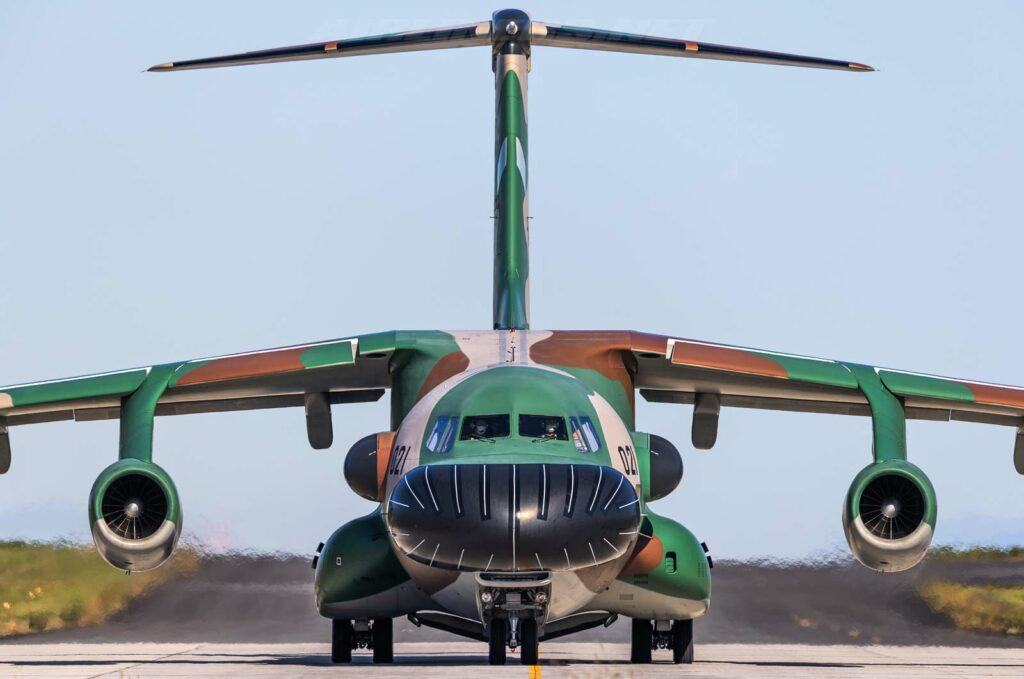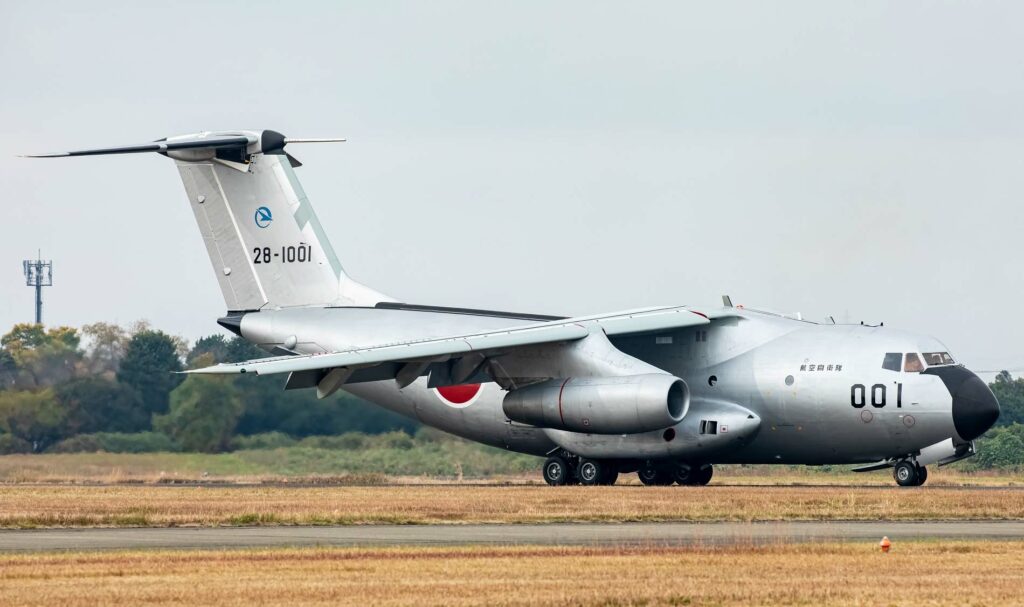A medium-range military transport aircraft, designed and manufactured by Kawasaki for the Japan Air Self-Defense Force (JASDF).
In brief
The Kawasaki C-1 is a twin-engine, medium-range tactical transport aircraft developed exclusively for the Japan Air Self-Defense Force (JASDF). Entering service in the early 1970s, it was designed to meet the specific logistic and transport needs within the geographical confines of Japan. Featuring a high-wing design for stability and unobstructed cargo space, a rear-loading ramp for efficient loading and unloading, and turbofan engines mounted on the rear fuselage to enhance performance and reduce noise, the C-1 has been a reliable workhorse. It has a payload capacity of approximately 12 tons and is capable of operating in short and semi-prepared runways, embodying the operational flexibility required for rapid deployment of troops and materials.

The Kawasaki C-1 transport plane
In the context of post-WWII Japan and its pacifist constitution, the nation’s defense strategy has been inherently defensive, focusing on the ability to rapidly respond to threats and provide logistical support across its islands. The development of the Kawasaki C-1 was a strategic move to modernize and enhance the JASDF’s transport capabilities, replacing older American-provided aircraft with a domestically produced model that could meet the unique demands of Japan’s geography and defense policy.
History of the Development
The Kawasaki C-1 project was initiated in the 1960s as part of Japan’s broader efforts to rebuild its industrial and technological capabilities. The Japanese government, seeking to foster domestic aerospace development and reduce reliance on foreign military equipment, encouraged the design of an aircraft that could perform in the diverse and often challenging terrains of the Japanese archipelago. Kawasaki Heavy Industries led the project, with the first prototype taking to the skies in 1970. This period was marked by Japan’s economic rise and the re-establishment of its technological prowess, with the C-1 program symbolizing national achievement in aerospace engineering. The aircraft was designed without a NATO nickname, reflecting its exclusive operation within the JASDF and not intended for export or deployment in NATO operations.
Design of the Kawasaki C-1
The design of the C-1 focused on versatility, durability, and operational efficiency. With a length of 29 meters (95 ft) and a wingspan of 30.6 meters (100 ft 5 in), its dimensions were optimized for medium-range missions. The high-wing configuration was selected for its benefits in lift and stability, essential for transport operations that might involve short takeoffs and landings. The rear-mounted turbofan engines, Pratt & Whitney JT8D-M-9, were a compromise between performance and maintenance, providing sufficient power for the aircraft’s roles while ensuring reliability and ease of service. The C-1’s cargo hold was designed for rapid conversion between troop transport and cargo missions, featuring a rear ramp for easy loading and a maximum payload capacity of around 12 tons. While its performance and capabilities were well-suited to Japan’s needs, the aircraft’s range and payload were limited compared to larger strategic airlifters, reflecting its intended role as a tactical asset rather than a strategic one.
Performance of the Kawasaki C-1
Equipped with two Pratt & Whitney JT8D-M-9 turbofan engines, each producing 64.5 kN of thrust, the C-1 boasts a maximum speed of approximately 806 km/h (500 mph) and a range of 2,000 km (1,243 miles) with a full payload. Its service ceiling is around 9,100 meters (30,000 feet), and it can operate from relatively short runways, a necessity for the dispersed and varied nature of Japanese air bases. When compared to other tactical transporters of its era, such as the C-130 Hercules, the C-1 offers a tailored balance between range, payload, and runway requirements, specifically engineered for the geographical and operational context of Japan.
Variants of the Kawasaki C-1
The Kawasaki C-1 fleet included a few specialized variants, such as the C-1FTB (Flight Test Bed) used for testing new aviation technologies. Another variant was the EC-1, an electronic warfare and surveillance version designed to train and evaluate defense against air-to-surface threats. Each variant built on the base C-1 platform, demonstrating the aircraft’s adaptability to different roles within the JASDF.

Military Use and Combat of the Kawasaki C-1
Primarily, the Kawasaki C-1 has been utilized in roles that leverage its transport capabilities rather than direct combat. Its operations have included logistical support, disaster relief, and humanitarian missions within Japan and in support of international efforts. The C-1’s design emphasizes rapid and flexible response, aligning with Japan’s defense strategy that prioritizes mobility and efficiency. While not designed for armed conflict, the C-1 has proven indispensable in training exercises and real-world operations that require the quick movement of troops and materials. It has not been sold to other countries, remaining a uniquely Japanese asset reflecting the nation’s focus on self-reliance and tailored defense solutions.
–
The Kawasaki C-1 transport aircraft exemplifies Japan’s post-war focus on specialized, domestically-developed defense solutions. It bridges the nation’s unique geographical challenges and strategic defense philosophy with technological and industrial capability. As the JASDF continues to modernize its fleet, the C-1’s legacy as a pioneer in Japan’s military aviation development endures, marking a significant phase in the country’s defense history.
Back to Transport planes.